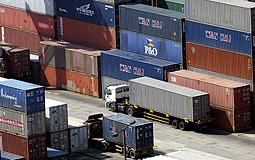 |
| Disaster prevention: Secretary for Economic Development & Labour Stephen Ip said the "Code of Practice on Mechanical Handling Safety in Container Yards" has already set out necessary precautions to be taken in high wind conditions. |

|
The Labour Department is exploring ways of preventing similar incidents after strong gales triggered two accidents involving empty containers on May 9, Secretary for Economic Development & Labour Stephen Ip says.
These include enhancing the inclement weather alert system for container yards and providing weather observation training for their safety officers and safety supervisors, he said.
The Labour Department and Hong Kong Observatory will organise safety seminars to brief the industry on how to watch out for bad weather and safety precautions to be taken under such circumstances, he added.
Mr Ip told lawmakers today the Hong Kong Observatory provides the average wind speed and direction measured at 18 local automated weather stations through its website and the "dial-a-weather system".
420 container yard accidents since 2000
Since January 2000, occupational safety officers made 1,963 container-yard inspections and issued 471 warning letters requiring proprietors to rectify irregularities found in their yards.
Most of the yards are located in Kwai Chung, Tsing Yi, Tuen Mun and Yuen Long. Common problems are unsatisfactory traffic and pedestrian control, unsafe use of mechanical equipment and working at height.
Between 2000 and 2004, a total of 420 industrial accidents occurred in container yards. Major causes were falls from heights, slipping or tripping and striking against objects, but none was related to the fall of containers under high wind conditions.
Mr Ip said the safe storage and stacking of containers in container yards are mainly regulated by the Factories & Industrial Undertakings (Cargo & Container Handling) Regulations and the Factories & Industrial Undertakings Ordinance the Labour Department administers.
36 prosecutions since 2000
Under the regulations, the proprietor of a container yard must ensure containers are stacked and stored in a safe and secure manner. Every employer has to ensure, so far as is reasonably practicable, the safety and health of employees at work, by providing and maintaining a safe system of work.
The Labour Department has published a "Code of Practice on Mechanical Handling Safety in Container Yards" to provide practical guidance to container yards proprietors.
Occupational safety officers conduct regular container yard inspections to ensure compliance with the safety provisions. On average, container yards are inspected once every six to 12 months.
The department also launches special enforcement exercises, targeting high-risk container yard operations and equipment.
Since January 2000, the department took out 36 prosecutions against the proprietors of container yards for failing to comply with safety provisions. These maximum penalty is a $500,000 fine and six months' imprisonment.
Preventive measures outlined in code
Mr Ip pointed out the "Code of Practice on Mechanical Handling Safety in Container Yards" has already set out safety precautions during high wind conditions. These include:
* giving special consideration to high wind conditions and the wind-induced funnel effect that could trigger the sliding or toppling of containers;
* reducing the wind's effect on containers, by limiting the stacking height, and using lashings (in particular on the exposed rows);
* stacking containers so that the longitudinal axis is in line with the predominant wind direction, and securing the containers at the corners of the block in case of a storm or typhoon warning;
* forbidding people from entering or remaining in a container stacking area if there is a reason to anticipate container movement due to wind; and
* suspending container lifting operations in adverse weather conditions.
Go To Top
|



